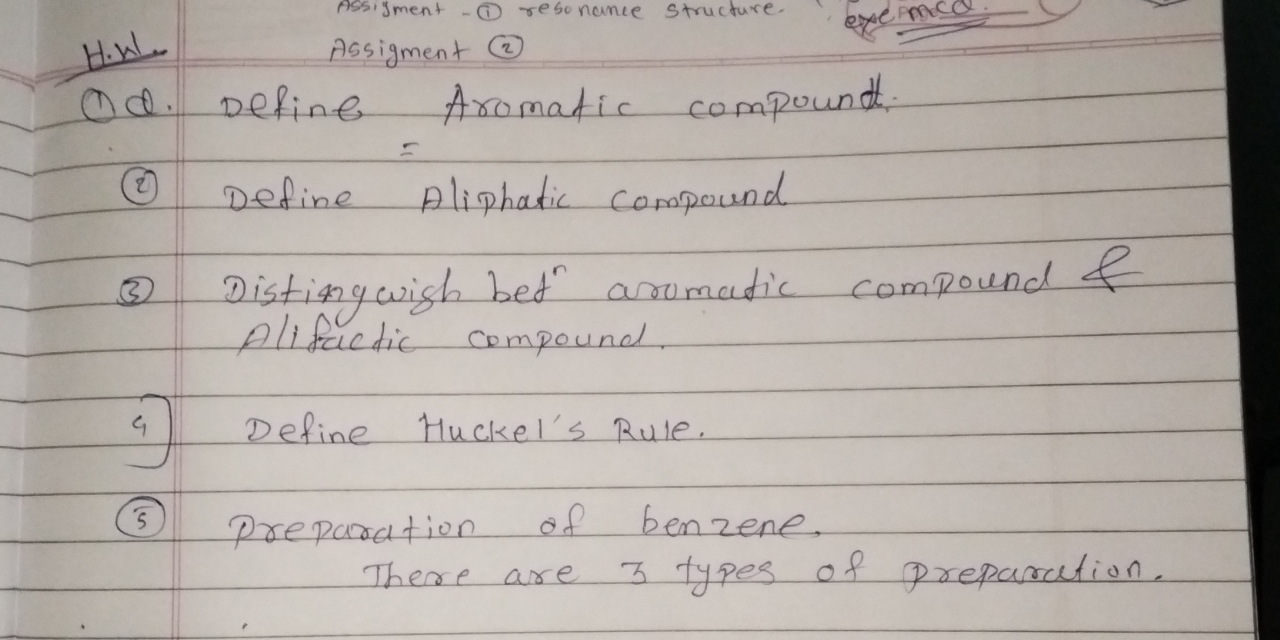1. Define aromatic compound. 2. Define aliphatic compound. 3. Distinguish between aromatic and aliphatic compounds. 4. Define Huckel's Rule. 5. What are the types of preparation of... 1. Define aromatic compound. 2. Define aliphatic compound. 3. Distinguish between aromatic and aliphatic compounds. 4. Define Huckel's Rule. 5. What are the types of preparation of benzene?

Understand the Problem
The question is asking for definitions and distinctions between various types of chemical compounds, particularly aromatic and aliphatic compounds, along with related concepts such as Huckel's Rule and the preparation of benzene.
Answer
1. Aromatic: Conjugated rings with delocalized pi electrons. 2. Aliphatic: No conjugated rings. 3. Aromatic vs. Aliphatic: Rings and pi bonds vs. none. 4. Huckel's Rule: 4n+2 π electrons for aromaticity. 5. Benzene prep: Decarboxylation, reduction of phenol, Wurtz-Fittig.
- Aromatic compounds contain conjugated planar ring structures with delocalized pi electrons, often exhibiting resonance. 2. Aliphatic compounds are straight or branched chains, or non-aromatic rings, lacking pi electron delocalization. 3. Aromatic compounds have ring structures with pi bonds, while aliphatic ones do not. 4. Huckel's Rule states that a planar cyclic molecule is aromatic if it has 4n+2 π electrons. 5. Benzene can be prepared by: (i) decarboxylation of benzoic acid, (ii) reduction of phenol, or (iii) Wurtz-Fittig reaction.
Answer for screen readers
- Aromatic compounds contain conjugated planar ring structures with delocalized pi electrons, often exhibiting resonance. 2. Aliphatic compounds are straight or branched chains, or non-aromatic rings, lacking pi electron delocalization. 3. Aromatic compounds have ring structures with pi bonds, while aliphatic ones do not. 4. Huckel's Rule states that a planar cyclic molecule is aromatic if it has 4n+2 π electrons. 5. Benzene can be prepared by: (i) decarboxylation of benzoic acid, (ii) reduction of phenol, or (iii) Wurtz-Fittig reaction.
More Information
Aromatic compounds, distinguished by their stability, are key components in organic chemistry due to their resonance. Huckel's Rule helps predict the aromatic nature of cyclic compounds. Benzene's preparation methods highlight its synthetic versatility.
Tips
Common mistake: Confusing the structural differences between aromatic and aliphatic compounds. Ensure recognition of ring vs. chain structures.
Sources
- Aliphatic vs. Aromatic Compounds | Properties & Examples - Lesson - study.com
- Aromatic Compounds - Definition, Example, Properties ... - BYJU'S - byjus.com
- 17.5: Aromaticity and Huckel's Rule - Chemistry LibreTexts - chem.libretexts.org
AI-generated content may contain errors. Please verify critical information